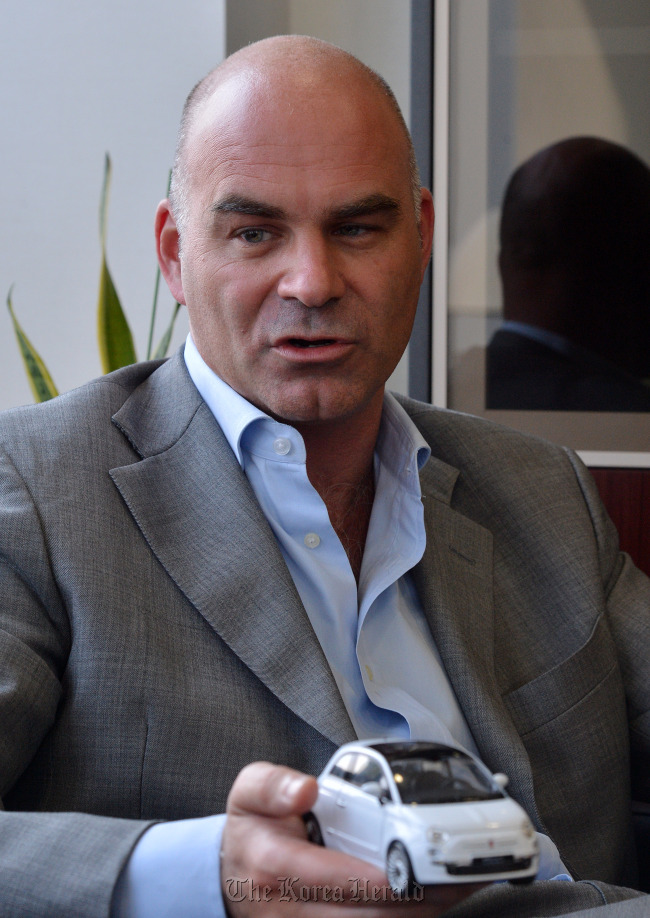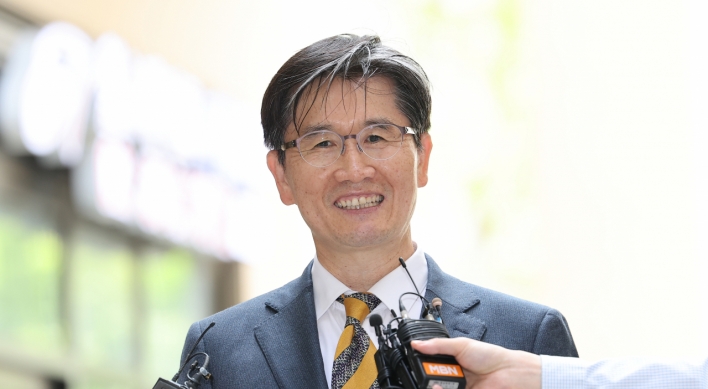Fiat aims to break through with 500
CEO calls Korea a ‘test-bed market’ for the iconic minicar
By Korea HeraldPublished : March 24, 2013 - 20:22
Cruising down Seoul in the Fiat 500 will definitely make you stand out.
Out of the 3 million cars on the roads of this bustling metropolis, there are only about 100 of these iconic subcompacts to be seen, as it was only launched in Korea in February.
It’s not the first time that the Italian carmaker has tried its hand here, but Fiat had to withdraw its Korean business in the late 1990s when its local manufacturing partner Kia Motors went bankrupt. Even at the time, the 500 ― born in 1957 ― had not been introduced to Korean customers.
“Korean consumers are really advanced in terms of trends. They are willing to accept changes. That brings us new opportunities,” Pablo Rosso, president of Fiat-Chrysler Korea, said of the reentry in a recent interview with The Korea Herald.
“Now people enjoy their life more than ever and buy a car to express themselves. The 500 is an automotive solution to the recent trend.”
Out of the 3 million cars on the roads of this bustling metropolis, there are only about 100 of these iconic subcompacts to be seen, as it was only launched in Korea in February.
It’s not the first time that the Italian carmaker has tried its hand here, but Fiat had to withdraw its Korean business in the late 1990s when its local manufacturing partner Kia Motors went bankrupt. Even at the time, the 500 ― born in 1957 ― had not been introduced to Korean customers.
“Korean consumers are really advanced in terms of trends. They are willing to accept changes. That brings us new opportunities,” Pablo Rosso, president of Fiat-Chrysler Korea, said of the reentry in a recent interview with The Korea Herald.
“Now people enjoy their life more than ever and buy a car to express themselves. The 500 is an automotive solution to the recent trend.”

As part of a plan to stem losses in Europe’s slumping auto market, Fiat is recently ramping up efforts to expand its presence in other markets, especially in Asia. And Korea, the CEO said, is a “test-bed market“ in the region.
“Downsizing is a trend in the auto industry. But in Korea the big sellers are still large sedans, especially so in the imported car market. The 500 is a fantastic option for the small car segment,” he said.
Despite the early excitement about the unprecedented car in the market, sales in the first month fell short of expectations. Fiat sold 85 vehicles in February, while its competitor Mini sold 293 during the same period.
But the CEO seemed not to be bothered by the first month performance, saying “We are here for long-term consolidation. And I’m quite satisfied with the early reaction from customers.”
His confidence may come from the carmaker’s experience in other markets. Despite its lackluster debut in the United States in 2011, Fiat outpaced Mini in January and February sales this year.
“I would not say Mini as our competitor. But consumers may compare the two cars as both of them are iconic cars and unique in the segment,” he said.
“For Fiat, there is a different harmony both inside and outside. Among other things, it is brand new in the market. And Koreans are always willing to embrace new things.”
Currently, Fiat has introduced three flagship models ― the Fiat 500, the 500C with a soft top and the Freemont compact sport utility vehicle ― in Korea. The 500 with a 1.4 liter engine is priced at 26.9 to 29.9 million won ($24,800-$27,500) depending on specs, about 15 percent cheaper than BMW’s Mini Cooper, a top-seller model in the same segment.
With diverse engine lineups awaiting launches in the coming months, the Korean branch plans to expand small car sales with the Fiat brand, while its Chrysler unit continues to specialize in the larger end of the market.
During the interview, the CEO, an Italian born in Argentina, was open about his profound pride and affection for Italy and everything Italian, calling the 500 “the very essence of the Italian lifestyle.”
“Italy and Italianess are loved all around the world. We have good taste of style, fashion and color. People embrace something Italian very easily and happily,” he said.
Rosso has been in Fiat Group since 2003 and mostly served in Europe. Except his two-year stay in India before coming to Korea, it is the first time for him to work in an Asian country.
“We always talk about crisis situation in Korea but I came from Europe where nobody is selling cars. The Korean car market is still growing and having that potential encourages me a lot,” he said.
“Handling three different brands ― Fiat, Chrysler and Jeep ― is also exciting as it gives me flexibility that I like. It’s really fun.”
Last year, Korea was the 14th-largest market for Fiat-Chrysler in terms of sales. According to Korea Automobile Importers and Distributors Association, it sold 4,123 vehicles last year, a 24.3 percent growth from 2011.
By Lee Ji-yoon (jylee@heraldcorp.com)
-
Articles by Korea Herald









![[Weekender] How DDP emerged as an icon of Seoul](http://res.heraldm.com/phpwas/restmb_idxmake.php?idx=644&simg=/content/image/2024/04/25/20240425050915_0.jpg&u=)

![[Today’s K-pop] NewJeans' single teasers release amid intrigue](http://res.heraldm.com/phpwas/restmb_idxmake.php?idx=644&simg=/content/image/2024/04/26/20240426050575_0.jpg&u=)






![[Herald Interview] Mistakes turn into blessings in street performance, director says](http://res.heraldm.com/phpwas/restmb_idxmake.php?idx=652&simg=/content/image/2024/04/28/20240428050150_0.jpg&u=)
